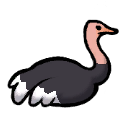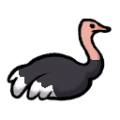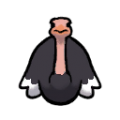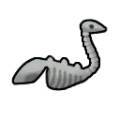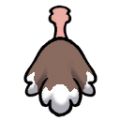Difference between revisions of "Ostrich"
m (→Analysis) |
Arcangelus (talk | contribs) (→Health: Changed to template version.) |
||
| (3 intermediate revisions by 3 users not shown) | |||
| Line 1: | Line 1: | ||
| − | {{ | + | {{Infobox main|animal |
| − | |page verified for version = 1.3.3087 | + | | page verified for version = 1.3.3087 |
| − | |name = Ostrich | + | | name = Ostrich |
| − | |image = Male Ostrich east.png | + | | image = Male Ostrich east.png |
| − | |description = The largest unmodified bird species, ostriches are known for their fast run, huge eggs, and powerful kick. It is easily angered. | + | | description = The largest unmodified bird species, ostriches are known for their fast run, huge eggs, and powerful kick. It is easily angered. |
| − | |type = Animal | + | | type = Animal |
| − | |movespeed = 6 | + | | movespeed = 6 |
| − | |min comfortable temperature = -8 | + | | min comfortable temperature = -8 |
| − | |max comfortable temperature = 50 | + | | max comfortable temperature = 50 |
| − | |flammability = 0.7 | + | | flammability = 0.7 |
| − | |marketvalue = 250 | + | | marketvalue = 250 |
| − | |filth rate = 8 | + | | filth rate = 8 |
| − | |eggsmin = 1 | + | | eggsmin = 1 |
| − | |eggsmax = 1 | + | | eggsmax = 1 |
| − | |eggs_avg = 1 | + | | eggs_avg = 1 |
| − | |eggtime = 3.33 | + | | eggtime = 3.33 |
| − | |eggs_unfertilized = false | + | | eggs_unfertilized = false |
| − | |bodysize = 1 | + | | combatPower = 85 |
| − | |healthscale = 1 | + | | bodysize = 1 |
| − | |hungerrate = 0.42 | + | | healthscale = 1 |
| − | |diet = herbivorous | + | | hungerrate = 0.42 |
| − | |leathername = birdskin | + | | diet = herbivorous |
| − | |wildness = 0.95 | + | | leathername = birdskin |
| − | |manhuntertame = 0.1 | + | | wildness = 0.95 |
| − | |manhunter = 1 | + | | manhuntertame = 0.1 |
| − | |roamMtb = 3 | + | | manhunter = 1 |
| − | |trainable = none | + | | roamMtb = 3 |
| − | |mateMtb = 12 | + | | trainable = none |
| − | |meatname = bird meat | + | | mateMtb = 12 |
| − | |babyscale = 0.1 | + | | meatname = bird meat |
| − | |lifespan = 45 | + | | babyscale = 0.1 |
| − | |juvenileage = 0.1 | + | | lifespan = 45 |
| − | |maturityage = 0.2222 | + | | juvenileage = 0.1 |
| − | |tradeTags = AnimalUncommon | + | | maturityage = 0.2222 |
| − | |attack1dmg = 11 | + | | tradeTags = AnimalUncommon |
| − | |attack1type = Scratch | + | | attack1dmg = 11 |
| − | |attack1cool = 1.5 | + | | attack1type = Scratch |
| − | |attack1part = feet | + | | attack1cool = 1.5 |
| − | |attack1stun = 14 | + | | attack1part = feet |
| − | |attack2dmg = 11 | + | | attack1stun = 14 |
| − | |attack2type = Bite | + | | attack2dmg = 11 |
| − | |attack2cool = 2 | + | | attack2type = Bite |
| − | |attack2part = beak | + | | attack2cool = 2 |
| − | |attack2stun = 14 | + | | attack2part = beak |
| − | |attack3dmg = 6 | + | | attack2stun = 14 |
| − | |attack3type = Blunt | + | | attack3dmg = 6 |
| − | |attack3cool = 2 | + | | attack3type = Blunt |
| − | |attack3part = head | + | | attack3cool = 2 |
| − | |attack3chancefactor = 0.2 | + | | attack3part = head |
| − | |livesin_aridshrubland = 0.7 | + | | attack3chancefactor = 0.2 |
| − | |livesin_desert = 0.6 | + | | livesin_aridshrubland = 0.7 |
| + | | livesin_desert = 0.6 | ||
}} | }} | ||
'''Ostriches''' are huge, flightless birds that are easily riled, found in [[arid shrubland]]s and [[desert]]s. Male adult ostriches are dark, while young and female ostriches are lighter brown.{{Check Tag|Verify|Verify in game}} | '''Ostriches''' are huge, flightless birds that are easily riled, found in [[arid shrubland]]s and [[desert]]s. Male adult ostriches are dark, while young and female ostriches are lighter brown.{{Check Tag|Verify|Verify in game}} | ||
| − | ==Taming== | + | == Taming == |
Ostriches can be tamed wild, randomly join your colony in an event, or bought pre-tamed from a trading ship. | Ostriches can be tamed wild, randomly join your colony in an event, or bought pre-tamed from a trading ship. | ||
| Line 62: | Line 63: | ||
== Analysis == | == Analysis == | ||
| − | Ostriches are one of many egg-laying animals that are inferior to [[chicken]]s. A hen lays {{#expr: ({{Q|Chicken|Eggs Per Clutch Average}}/{{Q|Chicken|Egg Laying Interval}}) / ({{P|Eggs Per Clutch Average}}/{{P|Egg Laying Interval}}) round 2}} for every ostrich egg. While an ostrich egg is worth {{#expr: 0.6 / 0.25 round 2}} chicken eggs, a ''single'' hen remains superior to an ostrich. | + | Ostriches are one of many egg-laying animals that are inferior to [[chicken]]s. A hen lays {{#expr: ({{Q|Chicken|Eggs Per Clutch Average}}/{{Q|Chicken|Egg Laying Interval}}) / ({{P|Eggs Per Clutch Average}}/{{P|Egg Laying Interval}}) round 2}} eggs for every ostrich egg. While an ostrich egg is worth {{#expr: 0.6 / 0.25 round 2}} chicken eggs, a ''single'' hen remains superior to an ostrich. 3 hens eat less food than 1 ostrich. Hens do not need to be fertilized, which adds a further advantage. |
While chickens cannot be found in the wild, the [[dromedary]] is superior to the ostrich. Dromedaries produce more food (in the form of [[milk]]), both per day and per nutrition fed. They are easier to tame, can be ridden on a [[caravan]], and found in all biomes that ostriches reside in. So if dromedaries are available, there's little point in keeping an ostrich pet. | While chickens cannot be found in the wild, the [[dromedary]] is superior to the ostrich. Dromedaries produce more food (in the form of [[milk]]), both per day and per nutrition fed. They are easier to tame, can be ridden on a [[caravan]], and found in all biomes that ostriches reside in. So if dromedaries are available, there's little point in keeping an ostrich pet. | ||
| Line 68: | Line 69: | ||
Therefore, ostriches are mostly relegated to hunting fodder and the occasional [[manhunter pack]]. Even then, dromedaries give more food and won't go manhunter when hunted. | Therefore, ostriches are mostly relegated to hunting fodder and the occasional [[manhunter pack]]. Even then, dromedaries give more food and won't go manhunter when hunted. | ||
| − | ==Attacks== | + | == Attacks == |
| − | Ostriches have three attacks: scratch (feet), bite (beak), and, less commonly used, blunt (head). In addition to the base damage, the scratch and bite attacks apply a stun for {{ | + | Ostriches have three attacks: scratch (feet), bite (beak), and, less commonly used, blunt (head). In addition to the base damage, the scratch and bite attacks apply a stun for {{Ticks|14}}. |
| − | ==Training== | + | == Training == |
{{TrainingTable}} | {{TrainingTable}} | ||
== Health == | == Health == | ||
| − | {{Animal Health Table}} | + | {{Animal Health Table|Bird}} |
== Gallery == | == Gallery == | ||
| Line 90: | Line 91: | ||
Dessicated ostrich east.png|Female and Young Decaying | Dessicated ostrich east.png|Female and Young Decaying | ||
</gallery> | </gallery> | ||
| − | ==Version history== | + | |
| + | == Version history == | ||
* [[Version/1.3.3066|1.3.3066]] - No longer trainable. Egg interval reduced from 19 days to 3.33. BaseHungerRate reduced from 0.55 to 0.42. Adult age 0.45 -> 0.2222 | * [[Version/1.3.3066|1.3.3066]] - No longer trainable. Egg interval reduced from 19 days to 3.33. BaseHungerRate reduced from 0.55 to 0.42. Adult age 0.45 -> 0.2222 | ||
| − | {{ | + | {{Nav|animal}} |
[[Category:Animals]] | [[Category:Animals]] | ||
[[Category:Wild animal]] | [[Category:Wild animal]] | ||
Latest revision as of 12:33, 1 July 2024
Ostrich
The largest unmodified bird species, ostriches are known for their fast run, huge eggs, and powerful kick. It is easily angered.
Base Stats
- Type
- Animal
- Flammability
- 70%
Pawn Stats
- Combat Power
- 85
- Move Speed
- 6 c/s
- Health Scale
- 100% HP
- Body Size
- 1
- Mass - Baby
- 6 kg
- Mass - Juvenile
- 30 kg
- Mass - Adult
- 60 kg
- Carrying Capacity
- 75 kg
- Filth Rate
- 8
- Hunger Rate
- 0.67 Nutrition/Day
- Diet
- herbivorous
- Life Expectancy
- 45 years
- Manhunter Chance
- 100%
- Manhunter Chance (Taming)
- 10%
- Trainable Intelligence
- None
- Wildness
- 95%
- Minimum Handling Skill
- 9
- Roam Interval
- 3 days
- Mate Interval
- 12 hours
- Maturity Age
- 0.222 years (13.3 days)
- Juvenile Age
- 0.1 years (6 days)
- Comfortable Temp Range
- -8 °C – 50 °C (17.6 °F – 122 °F)
Production
- Meat Yield
- 140
 bird meat
bird meat - Leather Yield
- 40
 birdskin
birdskin - Eggs Per Clutch
- 1 to 1
- Egg Laying Interval
- 3.33 days
- Can Lay Unfertilized Eggs
- false
Melee Combat
- Attack 1
- Feet
11 dmg (Scratch)
16 % AP
1.5 second cooldown
Stun for 280 ticks (4.67 secs) on first strike - Attack 3
- Head
6 dmg (Blunt)
9 % AP
2 second cooldown
0.2 chance factor - Average DPS
- 3.27
- tradeTags
- AnimalUncommon
Ostriches are huge, flightless birds that are easily riled, found in arid shrublands and deserts. Male adult ostriches are dark, while young and female ostriches are lighter brown.[Verify]
Taming[edit]
Ostriches can be tamed wild, randomly join your colony in an event, or bought pre-tamed from a trading ship.
Summary[edit]
Ostriches are pen animals. Once tamed, pen animals cannot and do not need to be trained any further. But if left outside of a pen or caravan hitching spot, pen animals will eventually roam outside your colony. Making a caravan is not required to tie animals to a caravan hitching spot.
A female ostrich produces 1 ostrich egg every 3.33 day when fertilized. Ostriches will not lay unfertilized eggs.
Analysis[edit]
Ostriches are one of many egg-laying animals that are inferior to chickens. A hen lays 3.33 eggs for every ostrich egg. While an ostrich egg is worth 2.4 chicken eggs, a single hen remains superior to an ostrich. 3 hens eat less food than 1 ostrich. Hens do not need to be fertilized, which adds a further advantage.
While chickens cannot be found in the wild, the dromedary is superior to the ostrich. Dromedaries produce more food (in the form of milk), both per day and per nutrition fed. They are easier to tame, can be ridden on a caravan, and found in all biomes that ostriches reside in. So if dromedaries are available, there's little point in keeping an ostrich pet.
Therefore, ostriches are mostly relegated to hunting fodder and the occasional manhunter pack. Even then, dromedaries give more food and won't go manhunter when hunted.
Attacks[edit]
Ostriches have three attacks: scratch (feet), bite (beak), and, less commonly used, blunt (head). In addition to the base damage, the scratch and bite attacks apply a stun for 14 ticks (0.23 secs).
Training[edit]
This animal can be trained as follows:
| Guard: | |
|---|---|
| Attack: | |
| Rescue: | |
| Haul: | |
*As of version 1.1.2610, all animals can be tamed. The percentage of likelihood of success depends on factors such as the Animals Wildness Percentage, Pawn Handling Skill, and others. More information can be found on the animals page.
Health[edit]
| Part Name | Health | Quantity | Coverage[1] | Target Chance[2] | Subpart of | Internal | Capacity[3] | Effect if Destroyed/Removed |
|---|---|---|---|---|---|---|---|---|
| Body | 40 | 1 | 100% | 19% | N/A[4] | - | Death | |
| Tail | 10 | 1 | 10% | 10% | Body | - | - | |
| Spine | 25 | 1 | 5% | 5% | Body | Moving |
−100% Moving[5] | |
| Stomach | 20 | 1 | 4% | 4% | Body | Digestion |
−50% Digestion | |
| Heart | 15 | 1 | 3% | 3% | Body | Blood Pumping |
Death | |
| Lung | 15 | 2 | 4% | 4% | Body | Breathing |
−50% Breathing. Death if both lost. | |
| Kidney | 15 | 2 | 3% | 3% | Body | Blood Filtration | −50% Blood Filtration. Death if both lost. | |
| Liver | 20 | 1 | 5% | 5% | Body | Digestion |
−50% Digestion | |
| Neck | 25 | 1 | 20% | 5% | Body | Eating Talking Breathing |
Death | |
| Head | 25 | 1 | 75% | 3.1% | Neck | - | Death | |
| Skull | 25 | 1 | 30% | 1.8% | Head | - | Cannot be destroyed. Increasing Pain based on damage. | |
| Brain | 10 | 1 | 60% | 2.7% | Skull | Consciousness |
Death Damage always results in scarring. | |
| Eye | 10 | 2 | 12% | 1.8% | Head | Sight |
−25% Sight. −100% if both lost. Damage always results in scarring. 0% Hit Chance against Blunt damage. | |
| Beak | 20 | 1 | 25% | 3.8% | Head | Eating Talking Manipulation |
−100% Manipulation −90% Eating[6] | |
| Leg | 30 | 2 | 10% | 5% | Body | Moving |
−50% Moving. −100% if both lost. | |
| Foot | 25 | 2 | 50% | 5% | Leg | Moving |
−50% Moving. −100% if both lost. |
- ↑ Coverage determines the chance to hit this body part. It refers to the percentage of the super-part that this part covers, before its own sub-parts claim their own percentage. For example, if the base coverage of the super-part is 100%, and the coverage of the part is 20%, 20% of hits would hit the part, and 80% the super-part. If the part had its own sub-part with 50% coverage, the chances would be 10% sub-part, 10% part, 80% super part.
- ↑ Target Chance is the actual chance for each part to be be selected as the target when each part's coverage has been taken into account(I.E. Neck covers 7.5% of Torso but Head covers 80% of Neck so it actually has only a 1.5% chance to be selected). This is not pure hit chance, as different damage types propagate damage in different ways. See that page for details.
- ↑ Note that capacities can affect other capacities in turn. Only the primary effect is listed. See specific pages for details.
- ↑ This is the part that everything else connects to to be considered 'connected'.
- ↑ If Moving drops below 16% a pawn cannot move.
- ↑ Note that eating won't go below 10%.
Gallery[edit]
Version history[edit]
- 1.3.3066 - No longer trainable. Egg interval reduced from 19 days to 3.33. BaseHungerRate reduced from 0.55 to 0.42. Adult age 0.45 -> 0.2222
